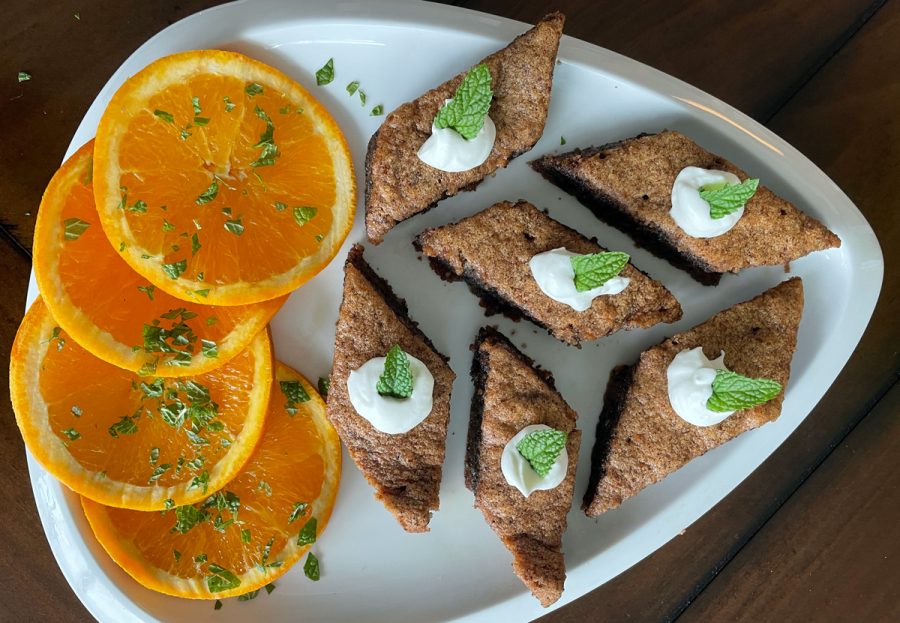A Sephardic Rosh Hashanah from Turkey
Published September 1, 2021
Leyla and Erman Kaspi are Jews from Turkey who I recently met outside the elevator of our Chicago apartment complex. After the usual introductions, I asked Leyla whether she still cooks the dishes with which she grew up.
“Of course,” she exclaimed.
That was the start of a lovely relationship. Leyla and I talked for hours about her family’s holiday foods and traditions, including their Turkish Rosh Hashanah seders. Before I share what I learned from Leyla, a brief history of Sephardic Jews in Turkey:
Although the Jewish presence in Turkey dates back more than 2,400 years, the majority settled there following their expulsion from Spain and Portugal in 1492. Sultan Bayazid II, ruler of the Ottoman Empire at the time, welcomed the Sephardim, seeing them as a benefit to the empire’s economy. Sephardim had religious freedom and autonomy in their Turkish communities, something they lacked in their former countries. As the Sephardim became key players in commerce, their numbers grew, eventually surpassing the Ashkenazi Romaniotes who pre-dated them.
The Jews from Spain and Portugal carried their unique culinary traditions with them to Turkey. And just like so many other groups of Jews, they adapted some of their dishes to reflect the cuisine and available ingredients in their new home. Vegetables and herbs such as eggplant, zucchini, dill, mint and sumac were plentiful in Turkey. Likewise, the foods of Turkey were influenced by Persian cuisine, which made Sephardic Turkish cuisine unique.
Leyla Kaspi was born in Istanbul. At home her family spoke mainly French and Turkish, and with her grandparents a little Ladino. She and her husband Erman, also from Turkey, remained there throughout the Holocaust, benefitting from Turkey’s neutrality during World War II. In 1942, the Wealth Tax legislation was imposed on non-Muslim citizens. This included Armenians, Greeks and Jews. When I asked Leyla whether she and Erman consider themselves Turkish Jews today, she emphatically said no, that they are Jews from Turkey.
Erman’s job took them to Athens, Greece in 1970, which was just the beginning of their version of the Wandering Jews. From Athens they moved to Rome, Italy, and seven years later to Windsor, England, where they lived for 35 years, splitting their time between England and Nice, France. They moved to Chicago 10 years ago to be closer to their two sons and families, which now include four grandchildren.
These facts were in my mind as I listened to Leyla describe her family’s Rosh Hashanah meal. She told me that while growing up in Istanbul, fruits and vegetables were part of every meal, purchased daily at the nearby market. However, in preparation for Rosh Hashanah, the purchases were far more specific. If fresh dates were available, they would take precedence over the dark ones. “Foods for Rosh Hashanah had to be light colored, and the fresh dates are golden,” Leyla explained.
Sesame seeds, pomegranates, apples, eggplants, peppers, zucchini, potatoes and whole blanched almonds were among the purchases. And, of course, a fresh whole fish such as red snapper, which the fish monger cleaned, detached the head and tail, and wrapped every part of the fish in one package.
To begin the holiday festivities, each of the Kaspi’s guests would kiss the other guests at the table. This lovely family custom precedes their Sephardic Rosh Hashanah Seder called Yehi Ratzon (“may it be thy will”), a tradition dating back 2,000 years to Talmudic times. Their seder begins with the lighting of the candles and the blessing over the wine. Next is the hamotzi over the bread. Rather than sprinkling the bread with salt, each guest dips his or her bread in sugar, for a sweet year.
There are additional blessings called simanim, which are recited over many of the items that Leyla arranges on a tray, including her homemade apple jam with whole blanched almonds, a pomegranate, an apple and a bowl of sesame seeds. For example, the blessing over the pomegranate is: “May we be as full of good deeds as the pomegranate is of seeds”; over the apple: “May it be your will, G-d, to renew us for a year as good and sweet as honey”; and a blessing over the fish head of Leyla’s pièce de résistance, a beautiful cooked and re-formed whole fish, adorned with sliced cucumbers to resemble fish scales: “May it be your will, G-d, that we should be heads and not tails; leaders, not followers.” Suffice it to say, the Turkish Sephardic version of the fish course is a far cry from the Ashkenazi gefilte fish.
Other foods for this special seder include prasa de kefta (leek patties), fritada de kalavasa (frittata of zucchini) and a Turkish ratatouille called turlu made from eggplant, potatoes, peppers and okra. While Leyla might serve a chicken dish as part of the menu, the meal is primarily made up of all the small dishes mentioned above. For dessert there are apple tarts or tishpishti (walnut cake—although on Rosh Hashanah, her grandmother made it with blanched almonds, to keep the color light).
If I’ve piqued your interest in a few of these Sephardic dishes, as Leyla piqued mine, I am including four Sephardic recipes below. You will notice that few spices are used in these dishes. Rather the delicious flavors are the result of using the freshest in-season produce and fresh herbs.
From my family to yours, Shanah Tovah!
Margi Lenga Kahn is the mother of five and grandmother of eight. A cooking instructor at the Kitchen Conservatory, she is working on a project to preserve the stories and recipes of heritage cooks. She welcomes your comments and suggestions at [email protected].
Recipe: Tispishti (Walnut Cake)
(Recipe adapted from “Sephardic Flavors,” by Joyce Goldstein)
Because this recipe has no flour or dairy, it can be served on Passover. Feel free to substitute blanched ground almonds (almond meal) for the walnuts. The almond meal does not need to be toasted.
Ingredients
Syrup:
2 c. granulated sugar
1 c. water
2 tbsp. fresh squeezed lemon juice
1 tbsp. orange-flower water (optional)
Cake:
Olive oil or butter for oiling pan
10 large eggs, separated
2/3 c. granulated sugar
2 tsp. baking soda
2 tbsp. fresh squeezed orange juice
1tsp. vanilla extract
1 ½ tsp. ground cinnamon
1/8 tsp. ground cloves
Grated zest of 1 medium orange
Grated zest of 1 medium lemon
2 c. finely ground toasted walnuts
1 c. stirred Greek yogurt or whipped cream for garnishing (optional)
Thinly sliced oranges, for serving (optional)
Fresh mint leaves, for garnishing (optional)
Directions
To make syrup, combine sugar, water, and lemon juice in a small saucepan; bring to a boil, stirring until sugar dissolves. Reduce heat to low and simmer for 8-10 minutes until mixture becomes syrupy. Remove from heat to cool. Once cooled, stir in optional orange-flower, if using. Reserve.
Oil or butter a 10x14x3-inch baking pan. Line the bottom with parchment paper and lightly butter or oil; set aside. Arrange rack in center of oven and preheat oven to 350 degrees.
To make the cake, beat the egg yolks in bowl of a stand mixer until pale yellow. With mixer on, gradually add sugar and beat until thick and pale.
Dissolve baking soda in orange juice and add to egg yolk mixture along with vanilla, cinnamon, and cloves. Beat until combined. Remove bowl from stand and fold in grated zest and all the ground nuts (be sure you have a full 2 c.); set aside.
In another bowl with clean beaters, beat egg whites to stiff peaks. Stir a third of the beaten egg whites into nut mixture above. Carefully fold in remaining egg whites, being careful to not deflate them.
Pour the batter into the prepared pan and bake cake for 22-25 minutes, or until a toothpick inserted in the center comes out clean.
Transfer cake to a cooling rack and let cool for 5 minutes. Using a toothpick or wooden skewer, evenly puncture the top of the cake about 16 times. Drizzle reserved syrup over cake and let cool completely.
Cut cake into squares or triangles and top with a dollop of whipped cream, if using.
Makes 8-10 servings. (Recipe can be easily doubled.)
Dulce de Mansana Con Almendras (Apple Jam with Almonds)
(Recipe by Leyla Kaspi)
Ingredients
2 lbs. Golden Delicious apples, peeled, cored, and grated
2 lbs. granulated sugar
3/4 c. water
Juice of ½ medium lemon
3 ½ oz. whole blanched almonds
Directions
Pour half the sugar and all the water into a saucepan. Add all the grated apples and cook over medium-high heat, stirring for 2 minutes until all the sugar has dissolved. Stir in remaining sugar and the lemon juice. Cook over medium heat until it has the consistency of jam, or measures 220-degrees on a candy thermometer.
Remove jam from heat and stir in whole almonds. Let cool and transfer to a lidded jar or covered glass bowl.
Recipe: Pichkado a la Mayonnaise
(Recipe by Leyla Kaspi)
Ingredients
1 ½ lbs. Red Snapper or Mediterranean Sea Bass
3 heaping tbsp. mayonnaise
1 tbsp. capers drained and rinsed
2c. court bouillon or 2 fish bouillon cubes dissolved in 2 c. water
Juice of ½ lemon
2 Persian cucumbers, or 4-5 small pickling cucumbers, for garnishing
Directions
Have the fish cleaned, reserving the head and tail.
Over medium heat, lightly boil only the body of the fish in bouillon, with the added juice of a half lemon, for about 10 minutes, or until the fish easily flakes with a fork. Reserving liquid, carefully remove fish and set it aside on a plate to cool.
To the reserved bouillon mixture, add the head and tail. Lightly boil for 5 minutes, or until the eyes of the fish have turned white. Remove the head and tail with a slotted spoon and set them aside to cool.
When the body of the fish has cooled, remove the skin and carefully debone, flaking the fish into a bowl. Add about 1 ½ tbsp. mayonnaise and fold together until evenly distributed. Fish should not be overly moist. If it is dry, add an additional teaspoon of mayonnaise.
Fold in capers and arrange fish on the center portion of a serving platter to look like the body of a fish. Place the head and tail at either end to complete the fish.
Lightly coat the top of the fish salad with remaining mayonnaise.
Very thinly slice the cucumbers with a mandolin or by hand. Arrange cucumbers on top of fish salad to approximate scales. Cover fish lightly with plastic wrap and keep refrigerated until ready to serve.
Makes 6 servings as a starter.
Recipe: Zucchini Peels in Lemony Tomato Sauce (Kashkarikas)
(Recipe adapted from Sefarad Yemekleri, by Viki Koronyo and Sima Ovadya)
Ingredients
About 2 ¼ lbs. zucchini
Juice of two tomatoes or 1 tsp. tomato paste
4-5 tablespoons of sunflower oil
½ bunch of dill, finely chopped
Fresh squeezed juice of 1 ½ lemons
Water (enough to just cover zucchini)
Ground black pepper, to taste
Salt, to taste
Directions
Wash the squashes well, then peel them into strips 3/4” wide. Cut each strip vertically into 4 pieces.
Put the tomato juice or paste, oil, lemon juice, salt, pepper, dill, and zucchini peels into a saucepan and add enough water to just cover zucchini. Cook over medium heat until sauce begins to thicken, about 8-10 minutes.
Taste, adding pepper and salt, as needed. Transfer to a serving bowl, cover with plastic wrap, and refrigerate until cold; serve.
Makes 8 side servings.

















